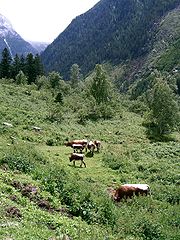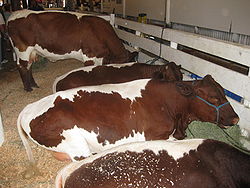
Pinzgau Cattle
Encyclopedia

Cattle
Cattle are the most common type of large domesticated ungulates. They are a prominent modern member of the subfamily Bovinae, are the most widespread species of the genus Bos, and are most commonly classified collectively as Bos primigenius...
breed from the Pinzgau
Pinzgau
The Bezirk Zell am See is an administrative district in the federal state of Salzburg, Austria, and congruent with the Pinzgau region....
region of the federal state of Salzburg
Salzburg (state)
Salzburg is a state or Land of Austria with an area of 7,156 km2, located adjacent to the German border. It is also known as Salzburgerland, to distinguish it from its capital city, also named Salzburg...
in Austria
Austria
Austria , officially the Republic of Austria , is a landlocked country of roughly 8.4 million people in Central Europe. It is bordered by the Czech Republic and Germany to the north, Slovakia and Hungary to the east, Slovenia and Italy to the south, and Switzerland and Liechtenstein to the...
. They are distinctively coloured, with chestnut brown sides and white back and underside. They can be naturally polled. The breed is classed as endangered.
History
According to genetic and morphological studies, the Pinzgauer cattle breed is most closely related to North German lowland breeds.The Pinzgauer was first referred to as a breed in 1846, and prior to this called "Pinzgauer Fasel" or "Pinzgauer Schlag." They were originally bred for milk, beef, and draft work. In the 19th century, they were bred into strong stock for work on farms, at breweries, and in sugar-beet areas. In its heyday, the Pinzgauer became the most popular cattle breed in Austria-Hungary
Austria-Hungary
Austria-Hungary , more formally known as the Kingdoms and Lands Represented in the Imperial Council and the Lands of the Holy Hungarian Crown of Saint Stephen, was a constitutional monarchic union between the crowns of the Austrian Empire and the Kingdom of Hungary in...
, subsequently expanding through Eastern Europe. The Bavarian Pinzgauer Cattle Breeding Association was founded in 1896. By December 1890, the Pinzgauer population had grown to 101,880 in Bavaria
Bavaria
Bavaria, formally the Free State of Bavaria is a state of Germany, located in the southeast of Germany. With an area of , it is the largest state by area, forming almost 20% of the total land area of Germany...
, but it eventually collapsed as a result of industrialization after World War I
World War I
World War I , which was predominantly called the World War or the Great War from its occurrence until 1939, and the First World War or World War I thereafter, was a major war centred in Europe that began on 28 July 1914 and lasted until 11 November 1918...
. Demand for the cattle decreased, and the breed was replaced by better milk-producing breeds such as Fleckvieh cattle
Fleckvieh cattle
Fleckvieh cattle started in 1830 when original Simmental Cattle from Switzerland were imported to Bavaria and to Austria to improve the local dual-purpose breeds. At these times, the Simmental cattle were famous for their milk production and draught capacity but were late maturing with little depth...
. By 1930, Bavaria had only 85,000 Pingzauer cattle.
The Pinzgauer breed has a naturally polled type, the Jochberg Cattle. These cattle descend from a single, almost totally white calf that was born in 1834 in Tyrol
Tyrol (state)
Tyrol is a state or Bundesland, located in the west of Austria. It comprises the Austrian part of the historical region of Tyrol.The state is split into two parts–called North Tyrol and East Tyrol–by a -wide strip of land where the state of Salzburg borders directly on the Italian province of...
. They were considered crippled and useless because they could not put on a yoke. Now that Pinzgauer are not yoked, and the hornless breed is best adapted to modern husbandry. There are now fewer than 50 hornless Pinzgauer cattle in the world, so the type is endangered. Since 1988, there have only been two hornless bulls at the insemination station near Salzburg
Salzburg
-Population development:In 1935, the population significantly increased when Salzburg absorbed adjacent municipalities. After World War II, numerous refugees found a new home in the city. New residential space was created for American soldiers of the postwar Occupation, and could be used for...
.
Characteristics
The animals are auburn in color. A luscious chestnut-colour is the breeding target. Black animals have occurred, but rarely, and were once seen as a curse. After 1900, black bulls were removed from the breeding system, and the black colour vanished. All Pinzgauers have the breed-typical white pattern in common: a broad white stripe lengthwise along the whole back. The abdomen, chest, udder, and tail are white as well.The weight of cows ranges from 600 to 700 kg, and cows average 137 cm in height. Bull weight ranges from 1,000 to 1,100 kg, and bull height is 147 cm on average.

Population and performance
The Pinzgauer breed is considered endangered, and the population decreases about 10% per year. In 2001 there were 36,000 animals in GermanyGermany
Germany , officially the Federal Republic of Germany , is a federal parliamentary republic in Europe. The country consists of 16 states while the capital and largest city is Berlin. Germany covers an area of 357,021 km2 and has a largely temperate seasonal climate...
, and worldwide there were around 1.3 million. In Austria
Austria
Austria , officially the Republic of Austria , is a landlocked country of roughly 8.4 million people in Central Europe. It is bordered by the Czech Republic and Germany to the north, Slovakia and Hungary to the east, Slovenia and Italy to the south, and Switzerland and Liechtenstein to the...
in 1995 there were 53,874 animals, 9,883 of which were registered in stud books.
Two conflicting tendencies caused the current rarity of purebred, high-performance animals. The Pinzgauer is mainly bred as a beef suckler cow, so there is no selection on milk performance. However, there are utility crossings with local or distinct beef breeds, too. In Austria itself, since 1969, Red Holstein
Holstein (cattle)
Holstein cattle is a breed of cattle known today as the world's highest production dairy animal. Originating in Europe, Holsteins were bred in what is now the Netherlands and more specifically in the two northern provinces of North Holland and Friesland...
have been crossed into Pinzgauer to increase the milk performance. The aim is to achieve 6,000 kg milk with 4% milk fat content and 3.5% protein. The average milk performance in Austria is 5,356 kg milk with 3.89% milk fat and 3.28% protein (2005).
Although Pinzgauer cattle fall behind other breeds on daily weight gain and grades, a special clientele admires the pronounced marbling of the beef. Nevertheless, the prices for Pinzgauer calves and steers are lower than for other breeds. Breeders are working to achieve a daily weight gain of 1,300 g.
-
In South Africa the breed has been selected primarily for its beef production and it has excelled outperforming many of the other breeds. In recent studies and tests, the breed came third out of all the major beef breeds in South Africa for ADG (Average Daily Gain) gaining 1.949kg per day! - the only two breeds doing better being the Charolais and Simmentaler.
The Pinzgauer performed best of all the breeds with FCR (Feed Conversion Ratio) needing only 5.63kg of feed, this together with the exceptional quality and marbling of the beef is making the breed a leader in the Beef industry in South Africa - SA Pinzgauer.
Ref: Beef Breeding in South Africa Michiel M Scholtz
Further reading
H.H. Sambraus: Gefährdete Nutztierrassen, Ulmer Verlag, Stuttgart 1994, ISBN 3-8001-4099-3 (German Language)External links
- Oklahoma State University breed profile
- Pinzgauer Cattle International
- American (U.S.) Pinzgauers Association
- Canadian Pinzgauer Association
- Pinzgauer Cattle Breeders' Society of South Africa
- Northwest Pinzgauer Breeders Association (U.S.)
- The Society for the Conservation of Old and Endangered Livestock Breeds (German Language)
- Bauernhof.net's Pinzgauer page (German Language)

